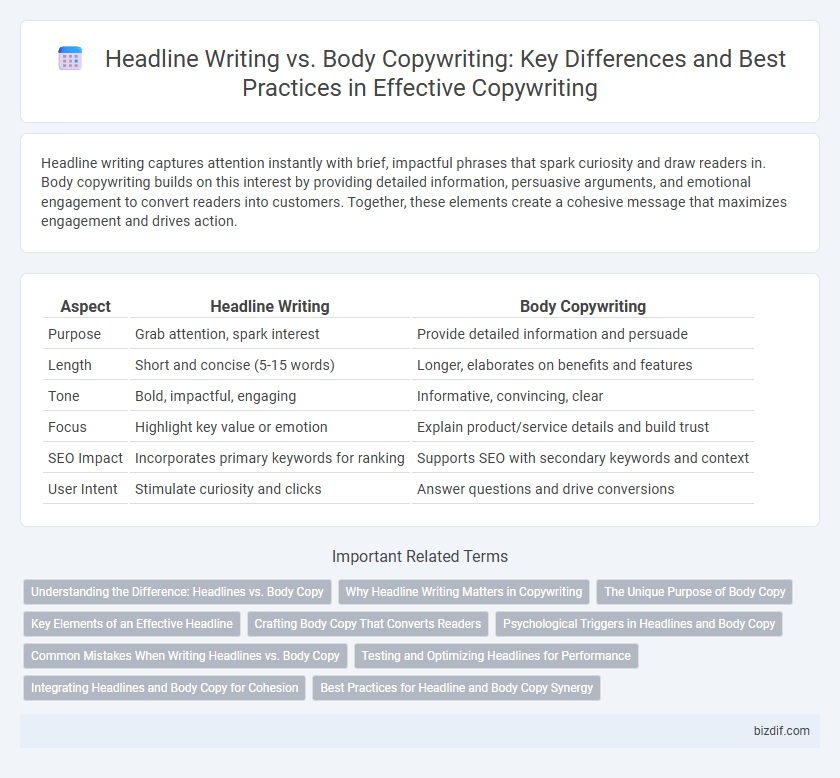Headline writing captures attention instantly with brief, impactful phrases that spark curiosity and draw readers in. Body copywriting builds on this interest by providing detailed information, persuasive arguments, and emotional engagement to convert readers into customers. Together, these elements create a cohesive message that maximizes engagement and drives action.
Table of Comparison
| Aspect | Headline Writing | Body Copywriting |
|---|---|---|
| Purpose | Grab attention, spark interest | Provide detailed information and persuade |
| Length | Short and concise (5-15 words) | Longer, elaborates on benefits and features |
| Tone | Bold, impactful, engaging | Informative, convincing, clear |
| Focus | Highlight key value or emotion | Explain product/service details and build trust |
| SEO Impact | Incorporates primary keywords for ranking | Supports SEO with secondary keywords and context |
| User Intent | Stimulate curiosity and clicks | Answer questions and drive conversions |
Understanding the Difference: Headlines vs. Body Copy
Headline writing captures attention through concise, impactful phrases that summarize the main message, while body copywriting provides detailed information and persuasive content to engage readers and drive action. Effective headlines prioritize keywords and emotional triggers to increase click-through rates and reader interest, whereas body copy emphasizes storytelling, benefits, and calls to action to convert prospects. Distinguishing headlines from body copy ensures clear communication and optimizes overall campaign performance in content marketing strategies.
Why Headline Writing Matters in Copywriting
Headline writing is crucial in copywriting because it captures attention and encourages readers to engage with the content, significantly impacting conversion rates. Effective headlines use targeted keywords and emotional triggers to create curiosity and convey the core message quickly. Crafting compelling headlines optimizes search engine visibility and drives higher click-through rates, setting the stage for persuasive body copy.
The Unique Purpose of Body Copy
Body copywriting serves the unique purpose of expanding on the headline by delivering detailed information, addressing customer pain points, and guiding readers toward a call to action. It builds trust through clarity and emotional connection, using persuasive language tailored to the target audience's needs. Effective body copy complements the headline by transforming initial interest into engagement and conversion.
Key Elements of an Effective Headline
An effective headline captures attention with clarity, relevance, and emotional appeal, using strong keywords that resonate with the target audience to drive engagement. It often incorporates power words, numbers, and triggers curiosity while maintaining concise and scannable phrasing for maximum impact. The headline sets the tone and expectation, guiding readers seamlessly to the persuasive, informative body copy that supports conversion goals.
Crafting Body Copy That Converts Readers
Effective body copywriting extends beyond headline appeal by delivering clear, persuasive, and benefit-driven content that resonates with the target audience's needs and desires. Incorporating strong calls to action, storytelling elements, and precise language enhances engagement and drives conversions by building trust and demonstrating product value. Data-driven techniques such as A/B testing and customer feedback analysis optimize body copy performance, ensuring higher click-through and conversion rates.
Psychological Triggers in Headlines and Body Copy
Effective headline writing leverages psychological triggers such as curiosity, urgency, and social proof to immediately capture attention and motivate clicks. In contrast, body copywriting uses emotion-driven storytelling, detailed benefits, and trust-building elements to sustain interest and drive conversion. Understanding the distinct psychological impact of headlines versus body copy ensures a cohesive message that maximizes engagement and sales.
Common Mistakes When Writing Headlines vs. Body Copy
Common mistakes in headline writing include using vague language, failing to grab attention, and neglecting keyword optimization, which results in lower click-through rates. In body copywriting, errors often involve overloading the text with jargon, lacking clear calls to action, and ignoring customer pain points, reducing engagement and conversions. Effective copy balances compelling, concise headlines with persuasive, informative body text tailored to the target audience's needs.
Testing and Optimizing Headlines for Performance
Testing and optimizing headlines is crucial for maximizing click-through rates and engagement in copywriting. Employing A/B testing tools to compare different headline variations allows marketers to identify the most compelling keywords, phrasing, and emotional triggers that resonate with target audiences. Continuous analysis of headline performance metrics, such as CTR, bounce rate, and conversion rate, drives data-informed refinements enhancing overall campaign effectiveness.
Integrating Headlines and Body Copy for Cohesion
Effective copywriting integrates headlines and body copy to create seamless cohesion that captures attention and sustains reader engagement. Headlines serve as powerful hooks, while body copy expands on the promise made, ensuring consistent messaging through aligned tone, style, and keyword usage. Optimizing this integration enhances conversion rates by guiding readers naturally from curiosity to action.
Best Practices for Headline and Body Copy Synergy
Craft compelling headlines by using clear, concise language that instantly communicates the core benefit or idea, incorporating targeted keywords to enhance SEO and attract attention. Body copywriting should expand on the headline by providing detailed, persuasive information that maintains reader interest through storytelling, emotional appeal, and calls to action. Ensuring headline and body copy synergy involves aligning tone, message, and value proposition to create a seamless narrative that maximizes engagement and conversion rates.
Headline Writing vs Body Copywriting Infographic

 bizdif.com
bizdif.com